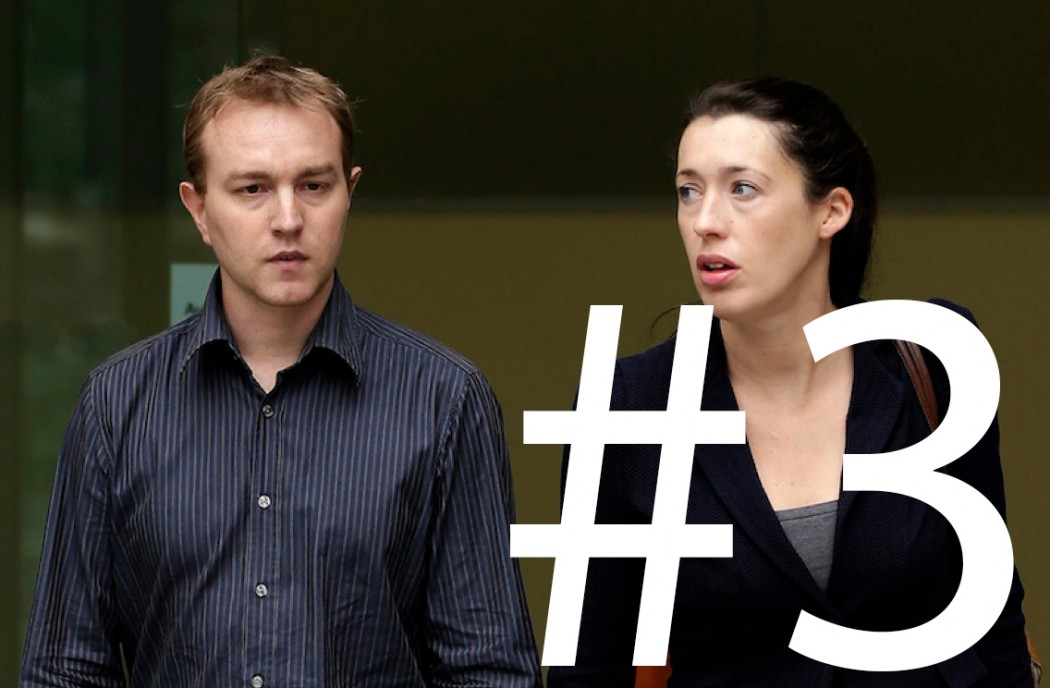When fraudulent activity permeates an entire industry how do you settle the score? Is everyone responsible? Are the low-level employees following orders the ones to blame? What about the people at the top, those with signs on their desks reading “The Buck Stops Here!” aren’t they responsible?
When the bubble burst and Americans lost their shirts people wanted to know who to blame. As details continue to emerge, we learn the misdeeds were such regular practice that it’s hard to know who wasn’t committing crimes. It might actually be easier to identify the innocent; just look for anyone who wasn’t making a killing!
The Wall Street Journal is running a series that looks at a man charged with manipulating Libor, an interest rate benchmark. He’s British. The series is a fascinating look into the prosecution of one of the only men charged with anything in the crisis. The reporter had incredible access:
It is unnerving to witness in high-definition the unraveling of a man’s life, even if that man is one of those pulling the thread. As a reporter for The Wall Street Journal, I had a surprisingly intimate perspective on Mr. Hayes’s growing despair. By the time of the car crash, I had been communicating with him for eight months, unbeknown to his lawyers or wife. We had dozens of clandestine meetings in train stations and rundown pubs—sometimes just after his lawyers warned him against speaking to the press.
He sent me thousands of text messages, at all hours of the day and night. Eventually his wife and other family members began confiding in me, too.
This account of the prosecution of Mr. Hayes and the toll it took on the former banker and his family is based on those conversations, and on legal documents and interviews with people involved in the case. I witnessed some scenes, and others were described to me in detail by Mr. Hayes, his wife and people close to them. I saw his family oscillate between pulling together and blowing apart. I observed Mr. Hayes, who was diagnosed as mildly autistic, swing from deep depression about his case to wild-eyed optimism that he would beat the law. And I watched in real time as Mr. Hayes took a risky U-turn that transformed him from the British government’s star witness to its chief adversary.
For a trader who always played the odds, always looked for an edge to exploit, it was a spectacular miscalculation.”
It’s a educational read. It also offer a vantage point we don’t usually see, where the reporter is writing himself into the story so that the reader understands the process and the relationship between the source and the journalist.
It was July 2013, and Mr. Hayes had become the global face of financial crime. If British and American prosecutors had their way, the former star trader would become one of the only bankers to go to prison for crimes committed during the financial crisis.
He had spent much of the year cooperating with British investigators. His intention was to plead guilty to charges that he masterminded an effort to manipulate one of the most important market measurements in the world—an interest-rate benchmark known as Libor.
The problem was, even after repeatedly admitting to acting dishonestly, he didn’t feel guilty. He didn’t want to testify against his alleged co-conspirators. And he couldn’t bear the thought of one day telling his son, Joshua, that he had admitted to being a criminal.
Ms. Tighe worked as a corporate lawyer, so she couldn’t keep watch over her husband all day. She dispatched her sister, Emma, to stop by the house each day to check on him. Emma secretly researched online how to rescue someone trying to hang himself.
That August, Mr. Hayes crashed his Mercedes on the way home from his favorite restaurant, KFC. Ms. Tighe wondered to a friend whether the wreck was an accident
—
Mr. Hayes admitted acting dishonestly, over and over. He had to in order to make sure he was charged.
“I probably deserve to be sitting here because, you know, I made concerted efforts to influence Libor,” he said at one point. “Although I was operating within a system…in which it was commonplace, ultimately I was someone who was a serial offender within that.”
—
Then the SFO got aggressive with Mr. Hayes’s family. One afternoon in mid-October, SFO agents showed up at the downtown London law firm where his wife, Sarah Tighe, worked. They presented her with a court order freezing her and their son’s assets. The order accused Ms. Tighe of trying to hide assets under her maiden name. Humiliated in her workplace, she had to explain to her employer why government agents had appeared in the firm’s lobby.
Mr. Hayes flew into a rage. He felt like he was being treated like a terrorist or drug dealer.
Tom Hayes: “They are even saying I am transferring stuff to my son who is 2!!!!!”
Tom Hayes: “They are really trying to screw my wife, it’s so below the belt”
Ms. Tighe had been using her maiden name all along. The SFO later said in court it had provided inaccurate information in obtaining the initial asset-freezing order, which was withdrawn.
The looming court fight energized Mr. Hayes. His depression faded. He resumed his fast-talking, aggressive manner. He was filled with renewed purpose.
There was a ton of work to do. The SFO handed over to Mr. Hayes’s lawyers more than 10,000 electronic files—emails, chat transcripts, phone calls, interview recordings, trading records, scanned printouts—that the agency had amassed in its investigation.
Mr. Hayes set up shop at his kitchen table. He stacked documents next to his son’s place mat and salt and pepper shakers. Fueled by endless cups of tea, he sifted through the documents, one by one. He built an interactive database that cataloged the mountains of evidence. The database allowed his lawyers to sort the materials by dozens of variables, including the seniority of executives involved in each piece of communication.
Then Mr. Hayes set out to figure out who had been affected by his trading and his alleged manipulation. The key was to determine who was on the other side of his trades.
This was a herculean task. Mr. Hayes executed 45,407 trades from 2006 through 2010. He went through each one. He calculated that almost all the Libor-linked trades, 99.8% of them, were with other banks. A total of 43 were with hedge funds or other asset managers. Mr. Hayes happily concluded that he hadn’t victimized any widows or orphans. Of course, that didn’t have any bearing on whether he had broken the law.






